Surgical Concept
A well-shaped facial contour and ratio play important roles in providing beautiful facial features; they also are unignorable components of a perfect facial sculpture. However, in Asians, prominent cheekbones and wide jaws are common facial characteristics, which may reduce the visual sense brought by facial features (such as the eyes and nose) or make the temples and cheeks look more sunken; even worse, in some cases, these characteristics may lead to the loss of feminine features because of a severe square-shaped face, which cannot be alternatively improved by other plastic surgeries. Accordingly, patients with a big or wide face need to consider facial bone reduction or other relevant bone reduction procedures to achieve a well-proportioned oval or slim face.
In medicine, there are several important reference points for a standard facial ratio that must be considered before facial bone changes. Based on his experience and observation of bone reduction surgeries, Dr. Chuang found that the frontal face width is mainly determined by zygomatic prominence/arches on the outer margin of both cheeks; patients with too high or too wide cheekbones can only choose zygomatic arch and body reduction surgery to fix their wide face, even though the cheekbones remain slightly wider than the jaws. The inferior mandibular bone/angle determines how slim the low face is and the shape of side view. If the mandibular bone is too wide or angular, differential diagnosis between the masseter muscle and mandibular bone hypertrophy should be made. Based on the underlying cause, patients may choose non-surgical injection of botulinum toxin to make their face look smaller temporarily or directly undergo mandibular bone reduction to fix their square-shaped faces. Several patients may choose to undergo combined reduction of zygomatic and mandibular bones to obtain an oval and slim narrow face. Dr. Chuang currently provides the most advanced 3D simulated imaging system for facial bone reduction to help patients understand the possible results in advance and increase the accuracy of and satisfaction with the surgery.
Besides the width of the zygomatic and mandibular bones, the length of the chin also has important effects on the proportion of the entire face. Usually, the standard distance from the end point of the chin to the lower lip should be longer than the length of the philtrum (the distance from the nose columella to the upper lip bead); the ratio of these distances in Asians is approximately 1.5:1. In the lateral profile, the golden ratio is when the nose supratip, anterior lower lip (or upper lip) margin, and the most prominent point of the chin are on the same line and when the jaw line presents a 45° angle (the line from the chin point through the mandibular bone to the earlobe). From the analysis of the above-mentioned reference points, the zygomatic bones, mandibular bone, and chin play very important roles in facial contour. If these three parts are greatly different in proportion or any part is more developed and prominent, it may be difficult to modify or correct facial bone defects by any simple blepharoplasty or rhinoplasty and patients may seriously consider undergoing facial bone or chin remodeling surgery. However, different from the obviously square-face features of Koreans, local patients’ faces are mostly flat and wide with a depressed mid-face and a short, fat, and retracted chin. Therefore, the mere pursuit of the golden ratio will make the face look artificial or unnatural, sometimes even too long or too pointed. Dr. Chuang suggests that moderate bone reduction consistent with the facial features of each patient is sufficient; if some deficiencies still persist, other facial plastic surgeries may be performed to achieve a natural look and avoid unnecessary complications and risks.
After being popular in Korea, facial bone reduction has been performed using a similar protocol and has already become a mature and common plastic surgery option. Surgical results depend on preoperative risk evaluation, operative accuracy and precision, complication avoidance, and most importantly, co-ordination of the entire facial ratio. Dr. Chuang went to Korea to study the skills of bone reduction in many clinics and hospitals. In combination with his unique esthetic sense and dedicated operation, Dr. Chuang may not only precisely control the ratio between the facial contour and facial features but also flexibly perform multi-site facial bone reconstructions on the basis of the individual conditions and requirements of each patient so that both single bone reduction and multiple bone reduction can be performed in accordance with the same esthetic standards. In addition, Dr. Chuang has abundant experience in various facial plastic surgeries and may perform integrated surgeries at one time, such as bone reduction, nose reshaping, chin augmentation, face lift, and facial implant placement. He always emphasizes “one-stop” overall facial bone reduction to properly complete complex facelift surgeries at one time. This strategy may reduce patients’ suffering from the recovery of several procedures, decrease the risk associated with anesthesia, avoid esthetic conflicts and revision possibility due to the procedures being performed using different skills and concepts of surgeons, and greatly diminish patients’ anxiety and uncertainty during the entire face changing period. Dr. Chuang may completely analyze and explain the potential sequelae and risks before surgery to patients to let them choose the most suitable surgery on the basis of their own requirements, thus avoiding the possibility of secondary re-repair or revision.
Dr. Chuang always upholds that the goal of facial bone surgery is not focusing only on the size and thickness of the bone or performing the procedures depending only on computer-simulated images; doing so may make the face rigid or stiff. The key to successful bone reduction for making people beautiful is to carefully listen to the thoughts of patients, take into account the standard ratio between facial features and bone shape, and perform operations that are most suitable for the requirements and characteristics of each patient. The various advanced facial bone surgeries currently provided by Wish clinic can truly make the dream of changing one’s face come true. Dr. Chuang believes that as long as patients can truly understand these procedures before surgery and choose the appropriate surgical option, every one may confidently move toward achieving the goal of a perfect face.
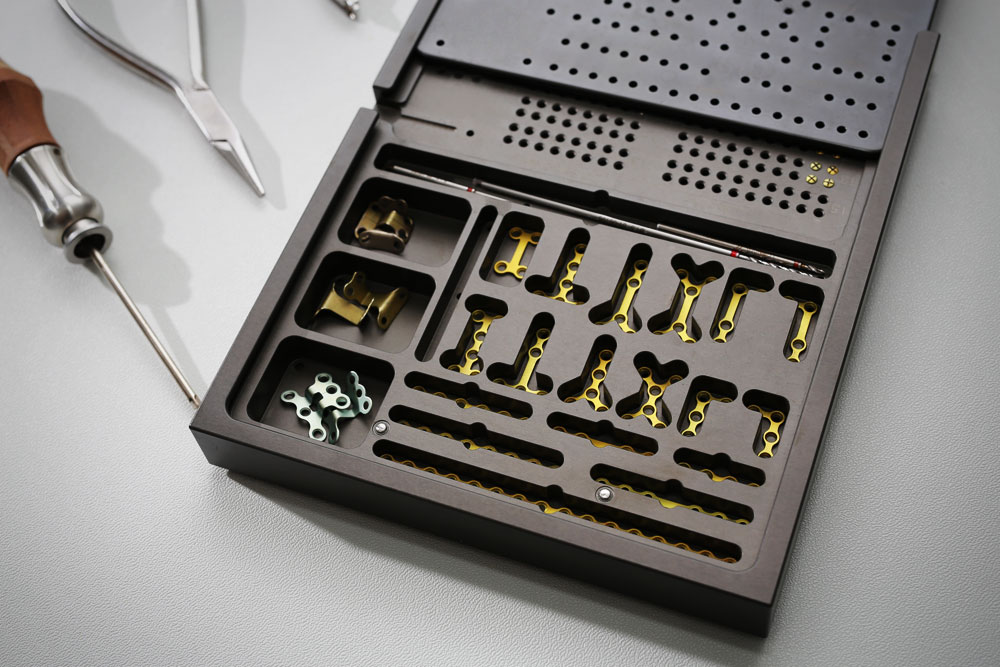
Use of the best surgical tools and fixation screws/plates can secure the result of cheekbone reduction.
Surgical Characteristics
Preoperative 3D Simulated Imaging-Predict The Future Facial Contours
A common experience of patients with facial bone reduction is the uncertainty regarding postoperative results. Although modern techniques can provide the bone image using various X-ray or computed tomography scans, such planar bone scans can only show surgeons useful information but not map the actual facial contour for patients. In other words, any radiological examination is too abstract and may not predict postoperative facial contouring changes. To improve reception gaps between doctors and patients and provide more reliable preoperative promises to patients, Dr. Chuang introduced the Axisthree 3D simulations system, which cost a million dollars. Patients can see their postoperative facial appearance on the computer after a simple 30-min imaging. This simulated imaging machine with software is currently the most advanced system in the world, with a virtual reality simulation of over 80%. Another important advantage of this system is that it can save these simulated images in cloud storage and transfer them to a computer in any operating room. Thus, the expected facial changes of each patient can be determined in real time, making it possible to perform the procedure on the basis of simulated images. Therefore, this device has a high reference value for both surgeons and patients; in particular, it could allow patients to bravely confront the challenge of changing facial features without facing an unpredictable future.
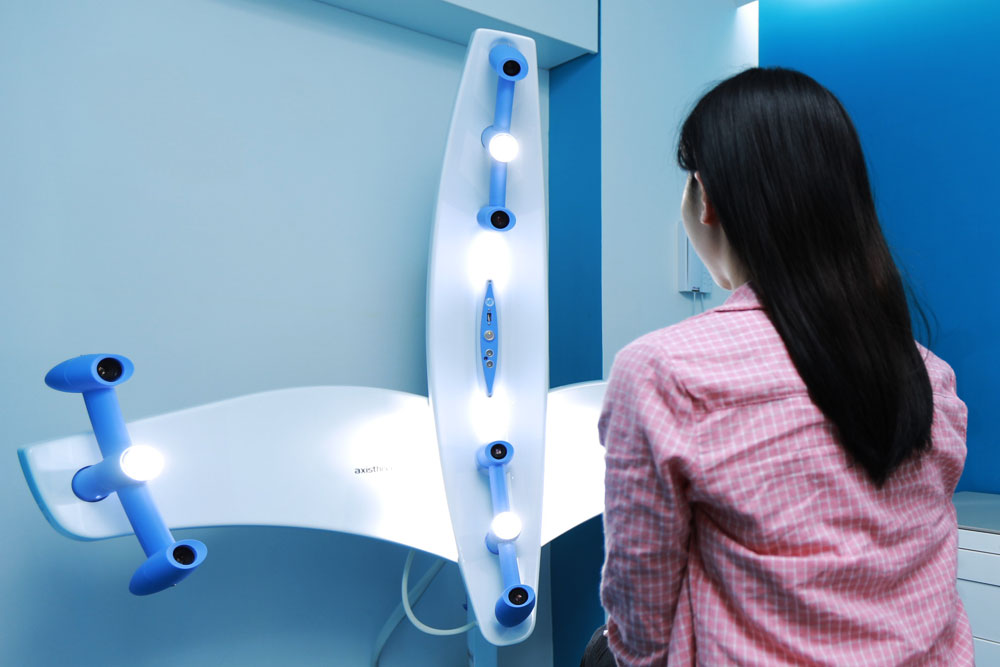
3D simulation not only establish the practical expectation of patients but also helping the surgeon to catch patient’s demand.
Application Of Different High-Speed Sawing Systems: Increased Surgical Safety And Efficacy
Facial bone reduction has already become a common procedure in plastic surgery; however, the good design and quality of surgical devices may reduce the risk of surgery. Accordingly, the primary objective at Wish clinic is to expand the use of high-quality surgical devices and tools to ensure the safety of patients. To guarantee the absolute safety of this procedure and considering the differences in patients with respect to bone angles and structures, Dr. Chuang recommends foregoing the traditional conservative opinion of “one device for whole surgery” and using two kinds of the most advanced electric bone sawing systems from Stryker and Aesculap. These devices are different in design concepts, handset functions, shaving speed, and the style and length of saw and may be alternately used during the procedure to fix various problems related to bone angle or bone anomaly, thus leaving no dead angle during the surgery and increasing the accuracy and efficiency of the procedure. The use of these two surgical tools can effectively reduce the time of the procedure and risk of anesthesia and shorten the recovery period; in addition, it can avoid intraoperative bleeding, nerve injury, or other sequelae resulting due to the use of inappropriate surgical devices.
Link: Stryker micro-type surgical electric saw / Aesculap micro-type surgical electric saw
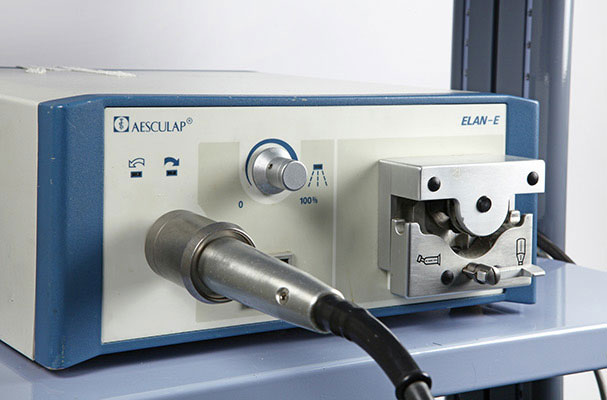
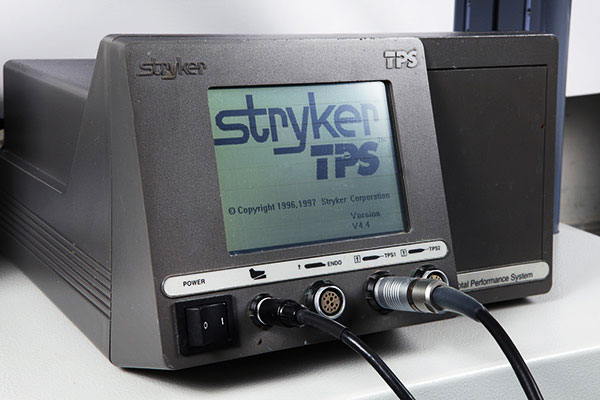
WiSH clinic has two high-speed sawing systems from Stryker and Aesculap for the facial bone surgeries.
Advanced LED headlight system: Perform surgery without visual blind spots
According to the classic Korean technique, facial bone reduction is performed through intraoral incisions; the surgical field is much smaller and narrower than that in percutaneous surgeries. Because of the unexpected change in the shadow angle and light intensity, the use of ceiling operating lamps or a hand-held light retractor can easily cause residual shadow or blurring in the deep structure of tissues, which may increase the risk of vessel or nerve injury. To reduce this unpredictable complication, Dr. Chuang not only set up high-focus LED operating ceiling lamps but also used an additional German HEINE 3S wireless LED headlight system for performing facial bone reduction. This device can provide sufficient light for the surgical field during the whole procedure; moreover, using the 4300 K color temperature, surgeons can clearly distinguish small structures such as nerves and vessels, effectively focus the vision field on deep tissues and bones, and avoid potential complications due to a blurred field, thus laying a strong foundation for successful results.
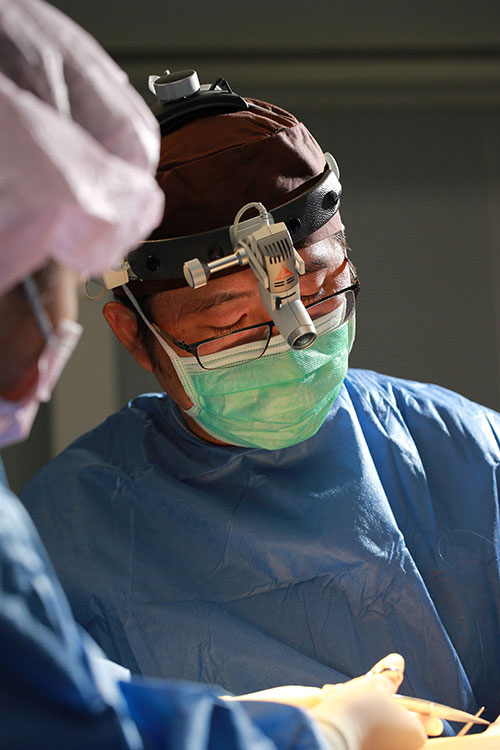
German HEINE wireless headlight system provides the most precise and refined surgical field for bone surgeries.
Hybrid facial reconstructions: Dream of changing one’s face comes true in one stop
Usually, patients who want to change their facial contour also have other requirements for reconstructing their facial features such as nose reshaping (rhinoplasty), chin implant (genioplasty), forehead lift (browplasty), or eyelid surgery (blepharoplasty); several patients even want to reconstruct their entire face. However, such surgeries should be conducted after precise calculation and integration as well as in accordance with esthetics standards to avoid conflicts in proportion or esthetics. Therefore, the ideal precondition for ensuring appropriate surgical effects and safety is the same plastic surgeon performing these procedures. To achieve the goal of performing hybrid surgeries, Dr. Chuang has been relentlessly investigating various surgeries related to facial feature reconstruction and facial bone sculpture; based on his abundant surgical experience, he provides patients with “one-stop” hybrid facial reconstruction procedures that combine facial bone reduction with various plastic surgeries including blepharoplasty, open rhinoplasty, submalar triangle or chin implant, and forehead/mid-face lift. Based on his unique esthetic sense, he even performs various personalized facial reconstructive surgeries for patients. There are two multi-functional operation rooms in our clinic, which are of the same level as those in teaching hospitals. We have anesthesia machines and physiological monitoring equipment as well as a qualified and experienced medical team. We ensure surgical safety with the strictest self-discipline so that patients can undergo long or combined procedures to fix their long-standing defects at one time. Thus, they would not need to ask different doctors to perform different plastic procedures, which occur in other clinics, because of limitations in terms of surgeons’ specialization or medical equipment. Different surgeons for different procedures may also increase the uncertainty of recovery on account of separate operations; moreover, patients may need to face unnecessary risks and experiences such as undergoing the surgery again in case of detrimental effects due to inconsistency among surgeons.
Combination of facial bone reduction with face lift: Avoid the risk of skin drooping
A reasonable risk in case of facial bone reduction is skin loosening or drooping caused by spatial separation between the skin and bone, which has to be performed during the surgery. Preventing or treating this potential sequela is critical to increasing patient satisfaction. At present, Dr. Chuang uses modified methods to reduce the subcutaneous dissection area as much as possible to prevent the possibility of postoperative skin loosening and introduces novel surgical concepts to keep pace with the developments in Korea. For patients with apprehension or predisposition for this complication, Dr. Chuang advises preventive surgeries (such as skin lifting or tightening procedures). In particular, for a few patients with original skin loosening, elderly patients, or patients likely to have cheek drooping after the operation, Dr. Chuang always suggests performing a mid-face temporal lift or jaw lift together with facial bone surgery to prevent and treat skin loosening caused by facial bone reduction. All these preventive surgeries are regional or involve a limited area; incisions are hidden behind the scalp hairline or earlobes and cannot be easily seen. These procedures may restore the tightening and rejuvenation of the skin at the same time as face reshaping and also avoid the possibility of a secondary facelift, thus effectively increasing patients’ satisfaction.
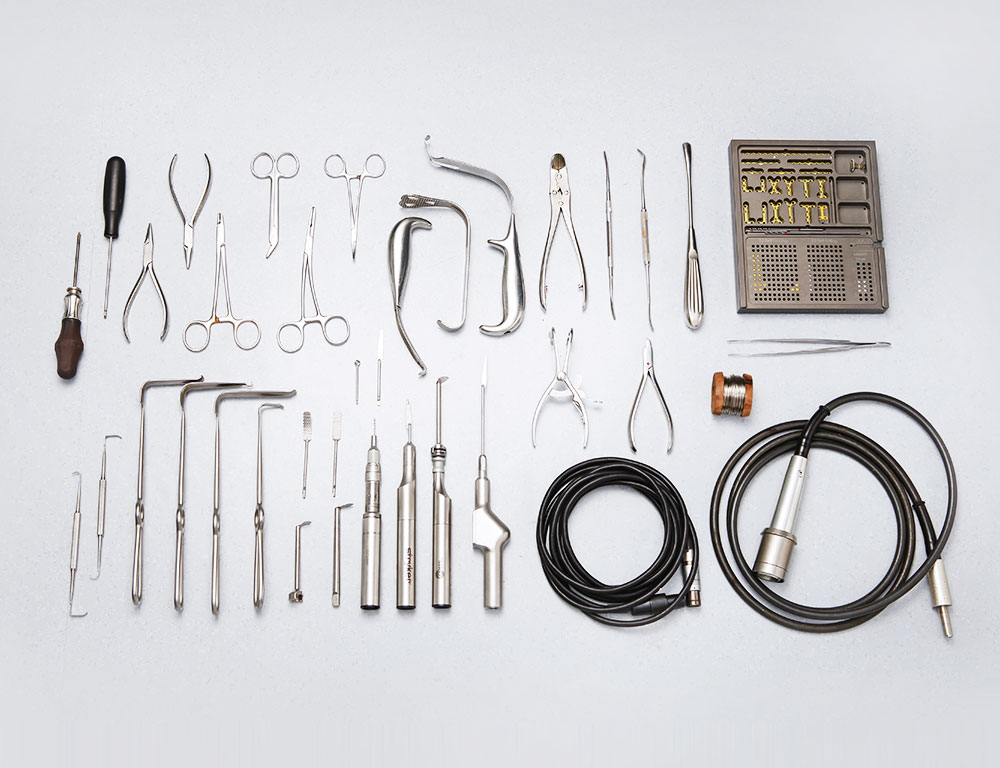
Flexible application of various surgical tools and instruments is the key to safety and success of facial bone surgery.
